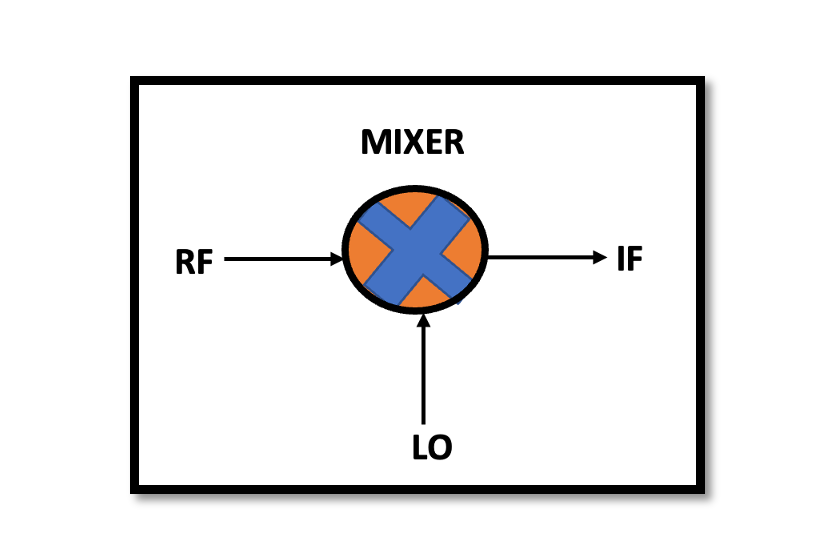
Introduction to Mixer Architectures in RF Systems
Introduction
RF mixers’ ability to perform downconversion is critical in various RF systems, including communication, radar, and wireless applications. It enables the efficient handling of signals by reducing their frequency to levels suitable for subsequent processing stages. Additionally, it aids in signal optimization, noise reduction, and overall system performance enhancement.
Understanding the interplay between RF mixers and the local oscillator is fundamental in designing RF architectures that achieve optimal signal processing, amplification, and data extraction within different frequency bands. In RF architecture, downconversion using RF mixers is a pivotal process in signal processing. This method involves converting higher frequency signals to lower frequency bands for easier processing and manipulation. The local oscillator (LO) plays a crucial role in this process.
Internal Structure and Operation:

Mixer Core:
- The heart of the mixer contains the nonlinear elements (such as diodes or transistors) responsible for signal mixing.
- Nonlinear devices exploit their nonlinear properties to produce sum and difference frequencies when RF and LO signals are combined.
LO and RF Ports:
- Local Oscillator (LO) port: This input provides the LO signal, which determines the frequency conversion.
- Radio Frequency (RF) port: This input contains the RF signal to be converted.
Intermediate Frequency (IF) Output:
- The output of the mixer contains the sum, difference, and possibly other harmonics or spurious frequencies.
- The IF output may go through additional filtering or processing to isolate the desired frequency component.

Importance in RF Systems:
- Mixer architecture significantly influences the performance of RF systems in terms of conversion loss, linearity, isolation, and spurious responses.
- Different architectures suit various applications based on requirements for frequency range, linearity, and rejection of unwanted signals.
- Selection of an appropriate mixer architecture is crucial in designing high-performance RF systems, ensuring optimal signal quality and system efficiency.
- Frequency Translation:
- RF mixers serve as the core components for frequency translation. They take an incoming RF signal at a higher frequency and combine it with the local oscillator signal to produce an output signal that contains both sum and difference frequencies.
- The difference frequency is the desired downconverted signal that lies within the desired frequency range for further processing.
- Bandwidth Management:
- High-frequency signals carry vast amounts of data but are challenging to process efficiently. Downconversion reduces the signal’s frequency, making it more manageable for subsequent stages in the system.
- Narrower bandwidths in lower frequency ranges are easier to process and amplify, enhancing signal quality and reducing system complexities.
- Signal Processing and Filtering:
- By downconverting the signal, it becomes easier to filter out unwanted noise and interference. Filtering is more effective at lower frequencies, aiding in signal purification and improving overall system performance.
Downconversion Process:
The downconversion process involves using an RF mixer to convert a high-frequency RF signal to a lower intermediate frequency (IF) or baseband frequency. This process occurs through the nonlinear mixing of the RF signal and the local oscillator (LO) signal within the mixer.
Equations:
The output of an ideal mixer can be described by the following equation:

Process Steps:
- Signal Mixing:
- The RF signal (VRF) and the LO signal (VLO) are fed into the mixer.
- The mixer’s nonlinearity causes the generation of new frequencies, including the sum and difference frequencies:

2. Downconversion:
- By setting the LO frequency appropriately, the desired frequency components (such as the difference frequency) can be obtained.
- The difference frequency, which represents the downconverted signal, is usually the one selected for further processing in the system.
Example Questions:
Question 1: If an RF signal of frequency 2.4 GHz is mixed with a local oscillator signal of frequency 2.1 GHz, what is the Intermediate Frequency (IF) produced?

Question 2: If an RF signal at 900 MHz is mixed with a local oscillator signal at 1 GHz, what are the frequencies present in the output signal?

Understanding the downconversion process with mixers is crucial in RF system design for frequency manipulation and signal processing, enabling efficient communication and data handling.
Common Mixer Architectures:
- Single-Balanced Mixer:
- Consists of a single diode or transistor acting as the mixing element.
- Utilizes a single-ended RF input and LO input.
- Offers basic frequency mixing capability but may exhibit higher conversion losses and limited port-to-port isolation.
- Double-Balanced Mixer:
- Employs two sets of diodes or transistors in a balanced configuration.
- Provides improved port-to-port isolation and reduced conversion losses compared to single-balanced mixers.
- Offers better linearity and often used in high-performance RF systems.
- Triple-Balanced Mixer:
- Utilizes three sets of diodes or transistors in a balanced configuration.
- Exhibits even better port-to-port isolation, improved linearity, and reduced spurious responses.
- Commonly found in high-frequency applications where stringent performance requirements are necessary.
- Mixer with Image-Reject Architecture:
- Designed to suppress unwanted image frequencies, improving selectivity in RF applications.
- Employs phase-shifting networks or hybrid couplers to eliminate undesired frequencies and enhance system performance.

Learn more about more topic like this. Browse various RF course on our website and watch the course videos for more detailed understanding https://rahsoft.com/courses/. Rahsoft also provides a certificate on Radio Frequency. All the courses offer step by step approach.
Tag:Mixer, Mixer Architecture, RF Mixers



